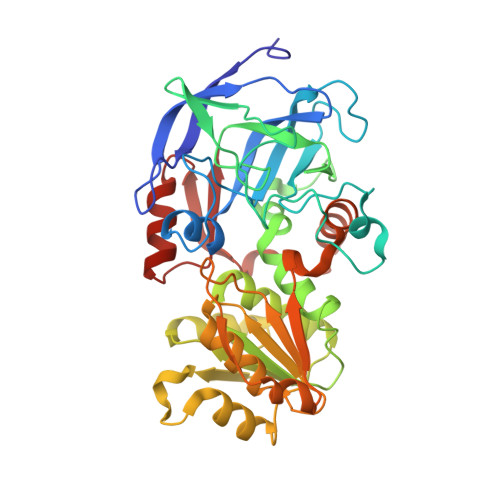Dependence of crystallographic atomic displacement parameters on temperature (25-150 K) for complexes of horse liver alcohol dehydrogenase.
Plapp, B.V., Gakhar, L., Subramanian, R.(2022) Acta Crystallogr D Struct Biol 78: 1221-1234
- PubMed: 36189742
- DOI: https://doi.org/10.1107/S2059798322008361
- Primary Citation of Related Structures:
5KJ1 - PubMed Abstract:
Enzymes catalyze reactions by binding and orienting substrates with dynamic interactions. Horse liver alcohol dehydrogenase catalyzes hydrogen transfer with quantum-mechanical tunneling that involves fast motions in the active site. The structures and B factors of ternary complexes of the enzyme with NAD + and 2,3,4,5,6-pentafluorobenzyl alcohol or NAD + and 2,2,2-trifluoroethanol were determined to 1.1-1.3 Å resolution below the `glassy transition' in order to extract information about the temperature-dependent harmonic motions, which are reflected in the crystallographic B factors. The refinement statistics and structures are essentially the same for each structure at all temperatures. The B factors were corrected for a small amount of radiation decay. The overall B factors for the complexes are similar (13-16 Å 2 ) over the range 25-100 K, but increase somewhat at 150 K. Applying TLS refinement to remove the contribution of pseudo-rigid-body displacements of coenzyme binding and catalytic domains provided residual B factors of 7-10 Å 2 for the overall complexes and of 5-10 Å 2 for C4N of NAD + and the methylene carbon of the alcohols. These residual B factors have a very small dependence on temperature and include local harmonic motions and apparently contributions from other sources. Structures at 100 K show complexes that are poised for hydrogen transfer, which involves atomic displacements of ∼0.3 Å and is compatible with the motions estimated from the residual B factors and molecular-dynamics simulations. At 298 K local conformational changes are also involved in catalysis, as enzymes with substitutions of amino acids in the substrate-binding site have similar positions of NAD + and pentafluorobenzyl alcohol and similar residual B factors, but differ by tenfold in the rate constants for hydride transfer.
Organizational Affiliation:
Department of Biochemistry and Molecular Biology, The University of Iowa, Iowa City, IA 52252, USA.


















